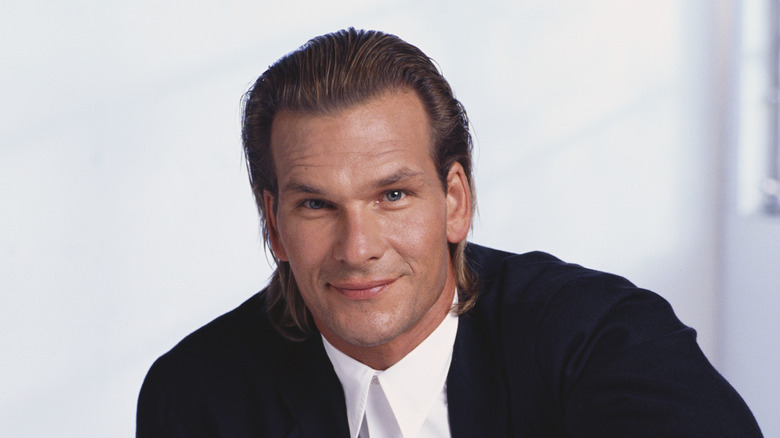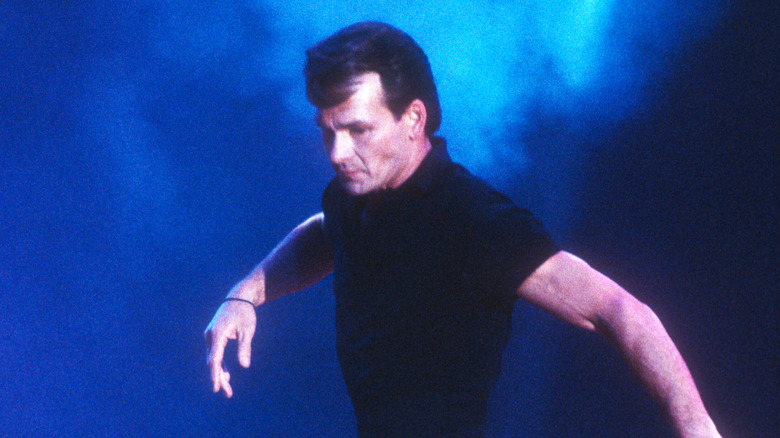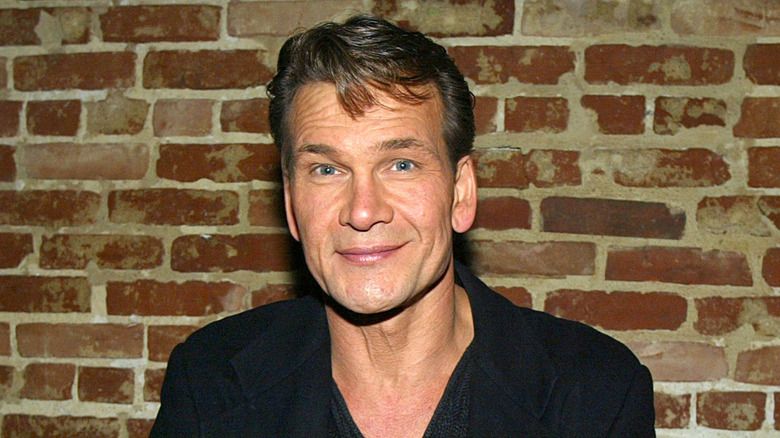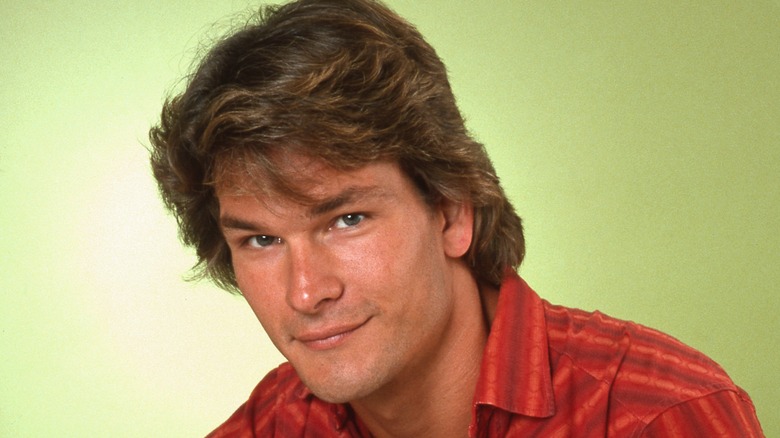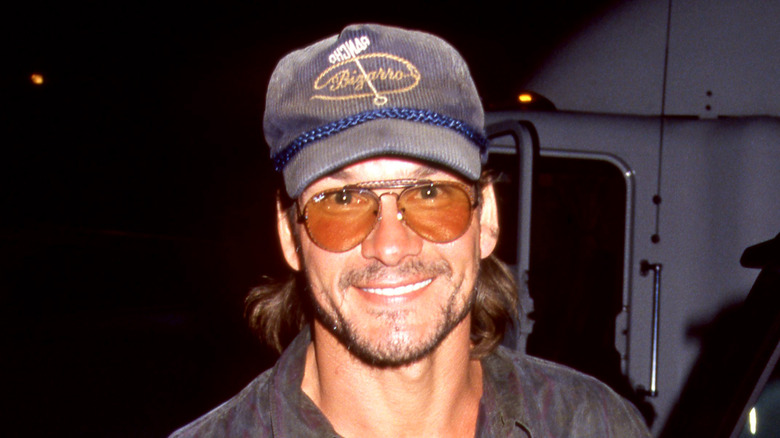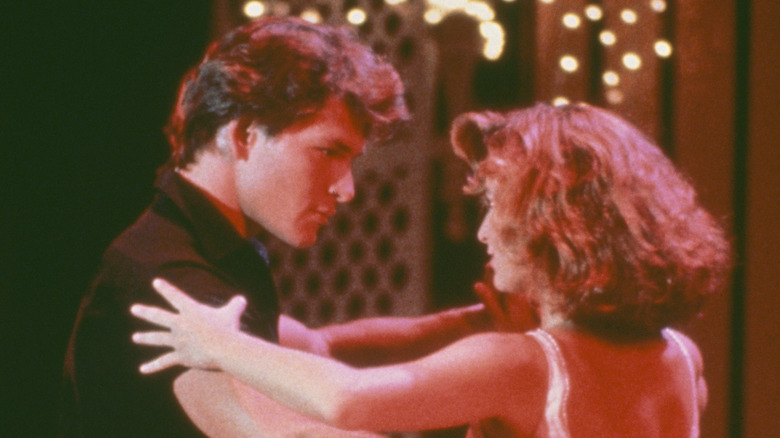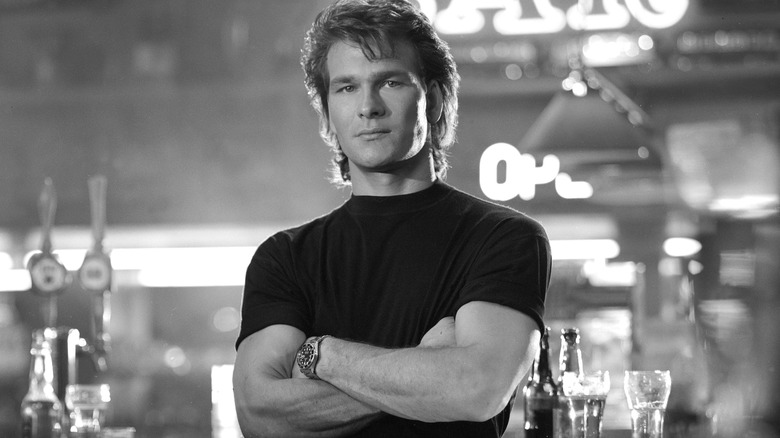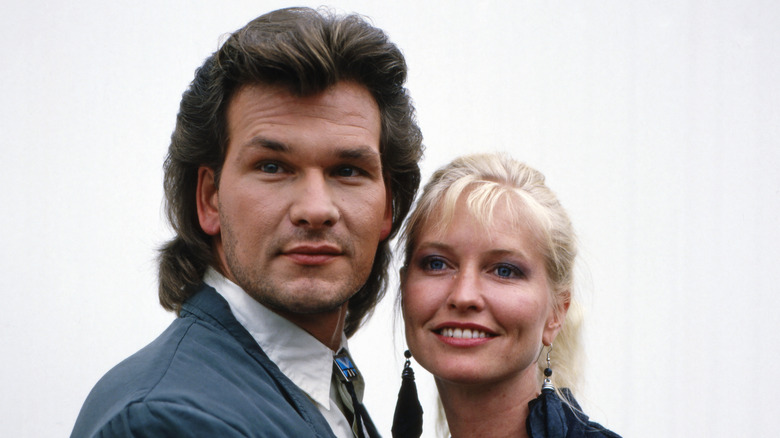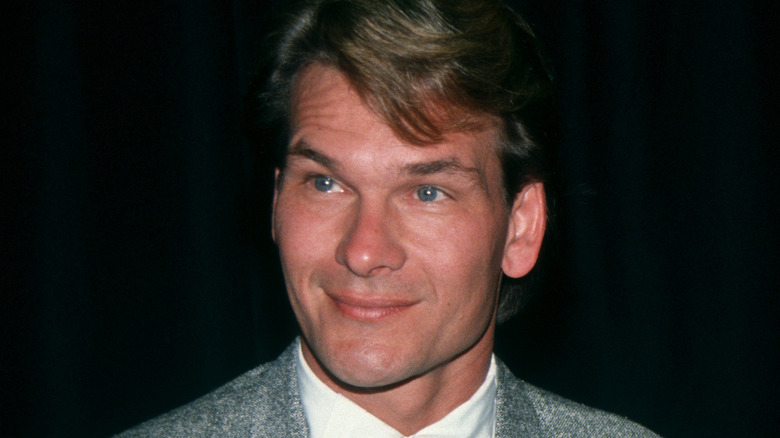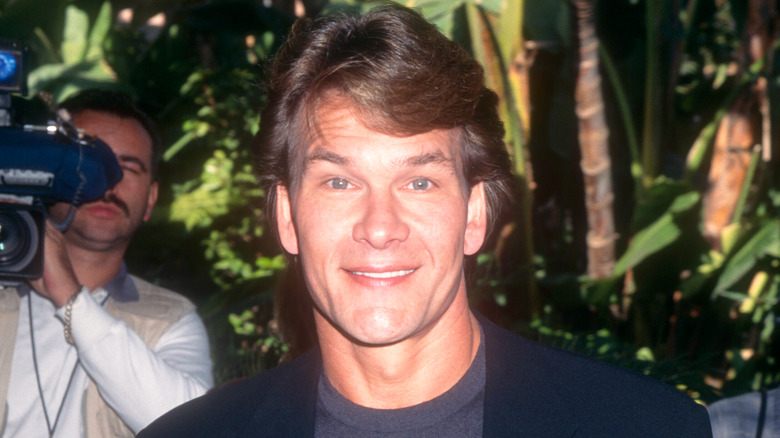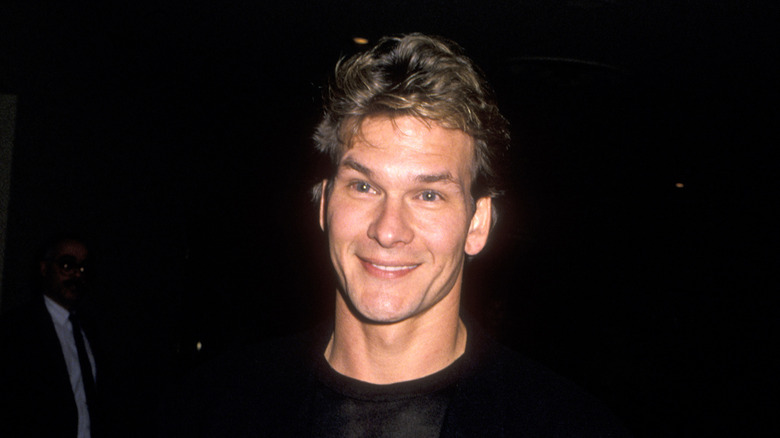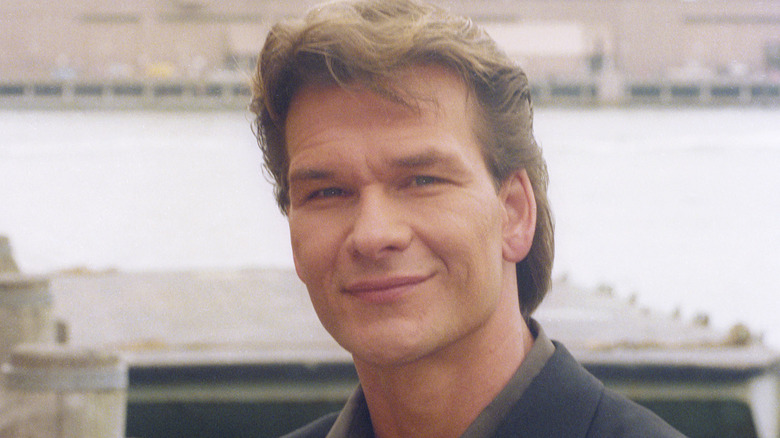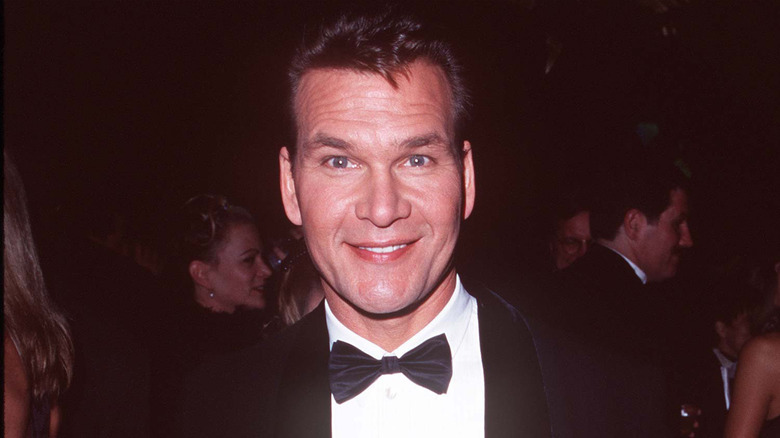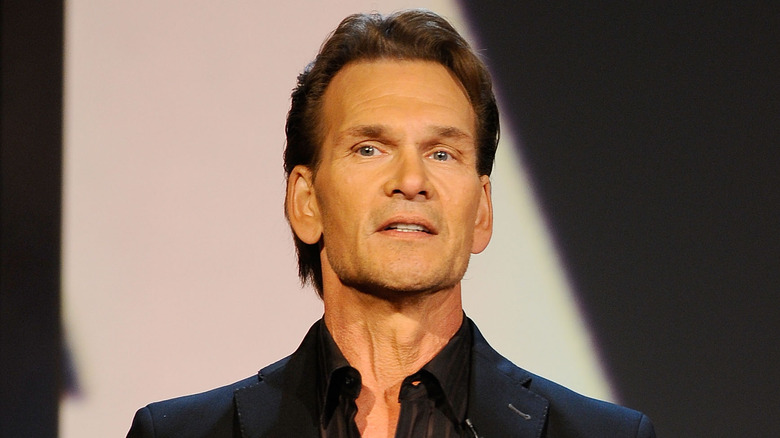The Tragic Truth About Patrick Swayze
The following article includes references to child abuse, miscarriage, addiction, suicide, and mental illness.
It has been over a decade since Patrick Swayze's 2009 death, but the beloved actor has never faded from memory. His most iconic films still run on television all of the time, and his legacy has been celebrated in multiple ways, including the documentaries "I Am Patrick Swayze" and "Patrick Swayze: Ghosts and Demons." Both documentaries were released in 2019 and highlight not only Swayze's successes but also the series of challenges he faced and the tragedies he experienced throughout his lifetime. From a variety of devastating injuries and deaths to a decades-long battle with addiction and mental health issues, Swayze's life was not without struggle.
Swayze started his acting career in the theater, which must have been easy after a life of performing on stage as a dancer. He made his film debut in 1979 and pumped out a slew of memorable performances in movies like "The Outsiders" and "Youngblood." He became a superstar in the late 1980s thanks to "Dirty Dancing," and solidified his heartthrob status (which he did not like) with 1990's "Ghost." But it was not all roses for Swayze, and unlike many actors of his generation, he was not afraid to get vulnerable and share details about his pain, traumas, and insecurities in interviews. He also courageously opened up in his memoir, "The Time of My Life," co-authored by his wife and released two weeks after his death. Here is the tragic truth about Patrick Swayze's biggest misfortunes, struggles, and heartbreaks.
He was bullied as a kid for being a dancer
Patrick Swayze was born in Houston, Texas, in 1952, where he was raised alongside his four siblings. His father worked as a chemical plant engineer draftsman, while his mother was a choreographer who founded the Houston Jazz Ballet Company. As happens in many families, Swayze adopted his parents' interests, which meant a life in which dance was at the forefront. Swayze grew up going to work with his mother — who has said she "didn't believe in babysitters" — and began taking ballet classes at only three years of age (via Biography). For a young boy in the South, especially at that time, dancing was certainly not the expected choice, and it made a young Swayze somewhat of a target in school.
Swayze has detailed being frequently teased by his classmates despite also being involved in more traditionally masculine sports like football and swimming and was the recipient of violence. Swayze revealed in his memoir that he was once jumped by a group of five boys, which prompted his father to teach him to fight. Swayze's parents encouraged him to take each boy on individually, and the docuseries "Patrick Swayze: The Price of Fame" suggests he did so, at least in part, to gain his father's approval. Swayze's memoir also mentions the ordeal and quotes his father as saying, "If I ever see you start a fight, I'll kick your a**. And if I ever see you not finish a fight, I'll kick your a**." (via Entertainment Weekly).
His mother was abusive at times
As we said, Patrick Swayze basically danced his way out of the womb. This early immersion in the art, paired with his mother's personality and problematic behaviors, created significant pressure for the youngster. His mother, Patsy, pushed him to the point where the average person might call it abusive, and her job as a choreographer made her especially critical. Though she was very strict and not always kind, Patrick remained close with his mom until his 2009 death (Patsy outlived her son by four years). "Patsy could be extremely critical and negative. But she figured out that if she was going to be around us, she needed to be a little nicer, and that's what she did," Patrick's wife, Lisa Niemi, said in the documentary "I Am Patrick Swayze" (via People).
Patsy was not only emotionally and psychologically abusive, but she also subjected Patrick to physical abuse when he was a young boy. On his 18th birthday, Patrick's father intervened and told Patsy he would leave if she ever hit their son again, causing the violence to stop. Niemi has largely attributed Patsy's behavior to her troubled upbringing and the cycle of generational abuse. "She could be very violent, but it was nothing compared to what she endured growing up and the stories I heard about what she went through with her own mother," she said in the film. While Patrick and his mother were close, they never spoke about the abuse.
If you or someone you know may be the victim of child abuse, please contact the Childhelp National Child Abuse Hotline at 1-800-4-A-Child (1-800-422-4453) or contact their live chat services.
A knee injury dashed his hopes of playing college football
Before he landed a career in acting, and even before he tried to become a ballet star, Patrick Swayze had his eye set on being a football player. It is unclear if he believed he could go pro, but it has been well established that he intended to play, at minimum, through the end of his university years. In fact, a young Swayze hoped to earn a scholarship to go to college based on his prowess in the sport. Had he actually played football in college, he would have joined a slew of other celebrities who played the sport at the college level, including Dwayne Johnson, Channing Tatum, Josh Duhamel, and Mark Harmon. But while Harmon turned down an NFL gig for an acting career, Swayze never had the choice. A devastating injury put an end to his football playing before he even made it out of those high school doors.
In his senior year of high school, during his second to last game of the season, Swayze experienced a knee injury so bad that it ended his football dreams for good. After the fact, he channeled all of his energy into his other passions — not just dance but also gymnastics, both of which helped him rebuild strength and mobility. Before long, he had reimagined his future, establishing a new goal of being a professional ballet dancer. However, that dream was also soon to end thanks to the actor's painful left leg injury.
A health crisis ended his budding ballet career
Though acting seems like a natural extension of dancing, as two forms of performance, an entirely different skill set is involved. For Swayze, those acting chops were not developed until ballet became an impossible career for him. For that, he has his high school leg injury to blame — although it almost feels like luck was just not on Swayze's side. Then again, luck was definitely on the public's side, considering Swayze's dashed hopes and dreams led him to acting, providing us with some truly iconic performances. In 1973, when Swayze was 23 and already showing signs of promise in the ballet world, he developed a gnarly tooth abscess that led to a dangerous staph infection in his bloodstream.
The infection settled in his injured leg, and the situation nearly escalated to the point where it needed to be amputated. Doctors were ultimately able to tackle the infection, but being a professional ballet dancer became another ruined dream for Swayze. "Leaving the ballet created a void in me that I spent years trying to fill," he once said (via The U.S. Sun). Feeling empty and in need of a new path, Swayze decided to move to Los Angeles to explore acting as a possible endgame. He started doing theater — appearing first in a traveling Disney show, then as a replacement Danny Zuko in "Grease," and later, as a dancer in "Goodtime Charlie" — and made his film debut in the 1979 movie "Skatetown U.S.A."
He was in extreme pain while filming Dirty Dancing
"Ghost," "The Outsiders," and "Point Break" are classic films that hold up to the test of time, but "Dirty Dancing" is something unto itself. Patrick Swayze has arguably never been better than he was as dance instructor Johnny Castle, in a role that earned him his first of three Golden Globe nominations. With its great quotability — Jennifer Grey's "I carried a watermelon" line, for one — and sexy dance sequences, the 1987 film permeated culture in a way few movies do. Swayze's utterance of "Nobody puts baby in the corner" is just as impactful upon the 1000th rewatch, and it is one of those films that will likely never fall out of style.
The film's most iconic image is when Swayze lifts Grey in the air during the dance their characters had meticulously rehearsed. The characters are seen practicing for this part of the dance in a lake earlier in the film, but it turns out that this particular scene was not nearly as easy as Swayze made it look. Not only was it horrifically cold, but because Swayze had fallen earlier in the shoot during the tree trunk balancing scene, he was in agonizing pain from the hit to his bad knee. He said, "Because most of the cartilage in my knee was gone, the bones were just grinding painfully on each other. And despite the fact that Jennifer was very light when you're lifting someone in the water, even the skinniest little girl can feel like 500 pounds." (via Express).
That big fight scene in Road House left him with four cracked ribs
"Dirty Dancing" is not the only film that led to injuries for Patrick Swayze. Another movie that caused him some pain was "Road House," a 1989 action flick about a bouncer hired to tame a rowdy Missouri bar being refurbished. In the movie, Swayze's character, James Dalton, is a tough guy who has no problem getting physical — which is clearly evident in the climactic fight scene toward the film's end. In said scene, Dalton gets into a brawl with a gang member played by Marshall Teague, and because Swayze did not want to fake anything, he decided to actually fight the other man. Both men walked away with a number of injuries after more than 70 grueling takes.
The fistfight sequence was filmed over five nights, with a stunt coordinator and a fight trainer working diligently behind the scenes. While Swayze broke Teague's eye socket, Teague took aim at Swayze's torso, hitting him with what he thought was a fake log and breaking his ribs. "I dropped to my hands and knees, gasping for breath, but the scene called for us to keep fighting. ... When you watch this scene in the movie, the exhaustion you see on my face is absolutely real," Swayze wrote in his memoir, adding, "I barely had the strength to drag myself out of the river after that fight." Teague revealed to MEL that nine people eventually jumped in to hold the actors down after the fight got too out of control.
He was devastated when his wife miscarried
Deciding whether or not to have kids is a personal choice, and plenty stars choose not to have children. But when it comes to Patrick Swayze's situation, remaining childless was not the original plan. Swayze met his wife, Lisa Niemi, in a dance class when he was 18 and she was 14, and they started dating two years later. They wed three years after that, in 1975, and remained married until Swayze died in 2009. Though they were quite young when they married, by all accounts, Swayze saw himself being a dad one day. "I couldn't wait to become a dad, to have a child with this woman I loved so dearly," Swayze wrote in "The Time of My Life" (via NBC Connecticut). "And I wanted to be the best father I could be — the kind of father my dad had been to me."
Swayze and Niemi were thrilled when they got pregnant in 1990 and completely shattered when they lost the baby not long after. They found out about the miscarriage when they went in to hear the baby's heartbeat and then ended up weeping with grief in the parking lot. The couple eventually started trying to conceive again, but they had no success during their years of trying. In "I Am Patrick Swayze," Naemi said she eventually brought up the possibility of adoption but that Swayze was firmly against the idea and wanted only biological children.
He went to rehab to treat his alcohol abuse
Patrick Swayze was a celeb who struggled with alcohol addiction, an ongoing problem for much of his adult life. There is, of course, no singular reason for why he drank, but a few key events contributed to his reliance on alcohol as a coping method. One of these was Swayze's general discomfort with fame after "Dirty Dancing" turned him into a mega movie star. "Trying to deal with fame, I got stupid and drank too much," he explained to People in 2007. "Trying to find what it is to be a real human being and what it is to live through fame was hard. But I feel fortunate that I've come out the other end." Like so many people, Swayze also did not see himself as the world saw him, so the image people projected upon him made him uneasy.
Swayze has said he was not a huge drinker until his father Jesse died of a heart attack in 1982 at 57 — eerily, the exact same age that Swayze was when he passed away. He drank heavily for the next decade until he hit his low while filming "Father Hood" and subsequently checked into rehab. He successfully got sober in 1993 but later relapsed. "Alcohol breeds self-pity, and I've resorted to it on and off throughout my life. But I kicked it by making other things more important," Swayze told the Daily Mail in 2005.
If you or anyone you know needs help with addiction issues, help is available. Visit the Substance Abuse and Mental Health Services Administration website or contact SAMHSA's National Helpline at 1-800-662-HELP (4357).
He was forever changed when his sister tragically died
One of Patrick Swayze's toughest moments was the death of his beloved father in 1982, but other deaths haunted him similarly. For example, his unborn son's death wreaked havoc on Swayze's mental state and pushed him further toward alcohol. Four years later, his sister Vicky's death left him reeling and created feelings of guilt. "Her death changed my life," Swayze said in an interview with The Daily Mail. "It was hard not to feel responsible, that I could have done something to prevent it. The longer your life goes on, the more death you face. After my father, my manager, and then my sister died, I started to feel like I was cursed."
Though he experienced many good things, his difficulties shaped who he was, and he was understandably shaken when his sister committed suicide in 1994. Not only was that a horrific situation in general, but Swayze had already assumed much responsibility for his sister then. The two were very close, and Swayze paid for all of his older sister's medical bills and living expenses. "I had to find something to believe in, outside of myself, to beat the guilt and blame I felt — particularly in Vicky's case," he said. "The only thing you can do in those circumstances is to find some kind of meaning."
If you or someone you know is struggling or in crisis, help is available. Call or text 988 or chat 988lifeline.org
He battled depression and felt trapped by his sex symbol label
According to Mental Health America, major depression affects more than 8% of American adults, or 21 million people, each year. Furthermore, nearly half of people will experience a diagnosable mental health condition at some point in their lives. Talking about mental health has become more normalized, but plenty of people still shy away from it. And back in the 1980s and 1990s, it was not something people discussed — certainly not ultra-masculine celebrity heartthrobs. It was depression, though, that led Patrick Swayze to alcohol abuse. His struggle with depression was ongoing, and it peaked when he experienced personal tragedies.
The miscarriage that Swayze and his wife experienced led him deeper into depression and alcoholism, issues that hit their peak during the filming of the 1993 movie "Father Hood." But even after getting sober in rehab that year, Swayze's depression remained a large problem. His sister's 1994 death was another rough spot, and his ongoing battle to be taken seriously as an actor also contributed. Swayze reportedly disliked his image as a sex symbol and desired to move beyond the pigeonholing he experienced. "I've always been very insecure and had these problems go on in my insides and this tension and this not liking myself stuff," Swayze said in a clip featured in "I Am Patrick Swayze" (via The Daily Beast).
If you or someone you know needs help with mental health, please contact the Crisis Text Line by texting HOME to 741741, call the National Alliance on Mental Illness helpline at 1-800-950-NAMI (6264), or visit the National Institute of Mental Health website.
He was almost paralyzed after being hurled from a horse
It is unclear why Patrick Swayze was so prone to on-set injuries, but we imagine it to be some combination of bad luck and a refusal to rely on stunt doubles. The actor experienced yet another horrible injury while filming the feature "Letters from a Killer," a forgettable 1998 thriller. During filming, Swayze was thrown from a horse and, after impact, was left unable to walk. He broke both his legs and was nearly paralyzed, but the incident did not impact his lifelong love of horses. In addition to the lower-body injuries, Swayze detached at least one tendon in his shoulder, with some sources suggesting four of them were severed.
Swayze reportedly had to be airlifted off the set, and it took 12 surgeries to repair the collective injuries, which required reconstruction using steel and titanium rods. Ever the professional, the actor returned to location to finish the movie once he had recovered enough. Still, the incident impacted his sobriety, much like other tragedies in his life. "He was fine for months and years, and then all of a sudden something would trigger in his mind." said bodyguard Frank Whiteley in the documentary "Patrick Swayze: The Demons and the Dance," explaining, "There were benders, and then there were normal times."
He barely cheated death while flying a plane
While Patrick Swayze was only 57 when he died, he had already cheated death more than once by the time of his passing. His closest call occurred in 2000 when the actor was piloting a private plane and made an abrupt and unexpected emergency landing. Like fellow actors John Travolta, Tom Cruise, and Hilary Swank, Swayze was a licensed pilot who enjoyed spending time in the air. The incident in question happened when he was flying from California to New Mexico in his Cessna 414A, trying to save his ranch, Rancho Bizarro, from an uncontrolled wildfire. Swayze flew at a low altitude because of an issue with the plane a month prior, wherein sticky residue impacted the outflow valve. After putting the plane on autopilot, Swayze lost consciousness and only awoke when he was about to hit the ground in Arizona.
Though the plane hit some light poles and street signs as it descended, the autopilot function had gone off, allowing Swayze to recover from the lack of oxygen. "Air traffic control radar showed that between Needles and my landing in Prescott Valley, I almost hit the ground eleven times. I flew between 6,500 and 11,500 feet, narrowly missing the mountains," he wrote in his memoir. "And my route looked like a strand of spaghetti, looping around with no purpose for about forty-five minutes." It was later reported that Swayze had empty alcohol bottles in the cockpit, and three witnesses were charged with lying to police.
His wife left him after he started drinking again
Anyone who has or knows someone who has struggled with addiction understands that recovery is a lifelong process. For every person who can abstain from their drug of choice without ever having a slide backward, plenty of others slip up, sometimes repeatedly. Patrick Swayze did not stay sober after leaving rehab for his alcoholism in 1993, and those closest to him have indicated that his drinking ebbed and flowed based on external circumstances and his inability to healthily process his feelings. Though Lisa Niemi had been involved with the actor for roughly three decades, Swayze's drinking — which escalated in the early 2000s — became too much to bear for his devoted wife.
In 2003, Niemi left while Swayze slept and moved to an apartment 20 minutes away. She refused to return until the actor made changes, as she felt his drinking turned him into a whole other person. "He had a different personality when he drank that much. He was the nicest man on the planet unless he'd had a drink," Niemi told The Times in 2010. "People or animals could have got hurt when he was like that. It's not good to be around anyone like that." Though she refused to stay and watch him self-destruct, Niemi and Swayze remained in daily contact and reunited the following year. It does not appear that Swayze relapsed again in the five years between their reunification and his death.
He died less than two years after his cancer diagnosis
It is always sad when a beloved celebrity dies, especially when there is a feeling that their time was cut short. Patrick Swayze was only 57 when he passed away, and it was a tragic end to a life filled with high highs and low lows. But Swayze's star never stopped shining. He was diagnosed with stage 4 pancreatic cancer at the start of 2008. The news became public in March, and he died only 20 months later. "My indigestion issues got gigantic and constant. And then I started thinking, I'm getting skinny. I dropped about 20 pounds in the blink of an eye," he explained to ABC News in January 2009.
"When you see it in the mirror, when all of a sudden, you pull your eyes down, and the bottom of your eyes go yellow, and jaundice sets in — then you know something's wrong." Swayze enrolled in an experimental drug trial and underwent chemotherapy — all while still showing up to work on the television series "The Beast." The prognosis was never good, given the deadliness of pancreatic cancer and his advanced stage. "There's a lot of fear here," Swayze said in that same interview. "There's a lot of stuff going on. Yeah, I'm scared. Yeah, I'm angry. Yeah, I'm [asking] why me. Yeah, I'm all this stuff." The disease eventually metastasized to Swayze's liver, and he died at his ranch in September 2009.

